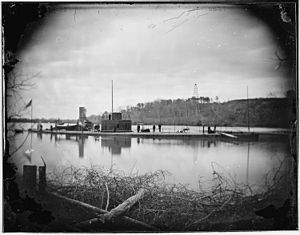| This article includes a list of general references, but it lacks sufficient corresponding inline citations. Please help to improve this article by introducing more precise citations. (February 2013) (Learn how and when to remove this message) |
 USS Lehigh on the James River USS Lehigh on the James River
| |
| Class overview | |
|---|---|
| Builders |
|
| Preceded by | USS Monitor |
| Succeeded by | Canonicus class |
| Subclasses | Uragan class |
| In commission | 25 November 1862 – 1899 |
| Completed | 10 |
| Lost | 2 |
| General characteristics | |
| Type | Monitor |
| Displacement | 1,335 tons |
| Tons burthen | 844 (bm) |
| Length | 200 ft (61 m) overall |
| Beam | 46 ft (14 m) |
| Draught | 10 ft 6 in (3.20 m) |
| Propulsion | 2 Martin boilers, 1-shaft Ericsson vibrating lever engine, 320 ihp (240 kW) |
| Speed | 7 knots (13 km/h; 8.1 mph) |
| Complement | 75 |
| Armament |
|
| Armor |
|
The Passaic-class ironclad monitors of the U.S. Navy saw service in the U.S. Civil War and the Spanish–American War. The class was an improved version of USS Monitor equipped with a 15-inch Dahlgren gun in place of one of the 11-inch guns.
Design


Naval architect and engineer John Ericsson designed the Passaic-class warships, drawing upon lessons learned from the first USS Monitor, which he also designed. The Passaic monitors were larger than the original Monitor and had their pilothouses atop the turret, rather than near the bow. This allowed a wider field of view and easier communications between captain, pilot and crew. The shape of the hull was an improvement; a fuller and rounder lower hull, far more boat-like than that of the Monitor, and with a less pronounced overhang. The Passaic class featured an 18 ft (5.5 m) funnel and improved ventilation. In combination, the significant hydrodynamic refinements and improved draught to the boilers resulted in a one-knot speed increase over the prototype monitor, despite the Passaic having a lower specific power than Monitor (Passaic being almost 400 tons heavier and yet with the same 320ihp-rated machinery).
Having observed the new 15-inch Rodman cannon in fortifications and disappointed with the performance of the 11-inch Dahlgren versus CSS Virginia, Assistant Secretary of the Navy Gustavus Fox required the new monitors to be equipped with at least one gun of 15-inch caliber, resulting in rush production of a new 15-inch Dahlgren. The turret was 21 ft (6.4 m) in diameter inside with the 15 in (380 mm) gun mounted flush because the muzzle diameter was too large for the turret opening. The large volume of propellant gases released inside the turret required the addition of a "smoke box" at the muzzle in the interior of the turret. As a result, the 15 in gunners could not see their targets and had to aim with the 8 in (200 mm) or 11 in (280 mm) guns. Lehigh had her 11-inch smoothbore replaced with an 8-inch Parrott rifle. Passaic also had this modification by July 1863, and, eventually, all surviving members of this class had an additional 15-inch smoothbore added. Later improvements included an additional 50 tons of deck plating over the magazines and machinery spaces as well as rings fitted around the turret and pilot houses to prevent their pivoting machinery from being jammed by shot.
Ships in class
Warships of Passaic class included:
The first ship of the class was named for the city of Passaic, New Jersey.
See also
- Uragan-class monitor, an Imperial Russian Navy monitor type built to the plans of the American Passaic class.
Notes
- Silverstone, p. 5
- Silverstone, p. 5
- Tucker, Arming the Fleet pp. 218–220
- Olmstead, The Big Guns, p. 91
- Olmstead, The Big Guns, p. 94
References
- Canney, Donald L. (1993). The Old Steam Navy: The Ironclads, 1842–1885. Vol. 2. Annapolis, Maryland: Naval Institute Press. ISBN 0-87021-586-8.
- Gibbons, Tony (1989). Warships and Naval Battles of the Civil War. New York: Gallery Books. ISBN 0-8317-9301-5.
- Olmstead, Edwin; Stark, Wayne E.; Tucker, Spencer C. (1997). The Big Guns: Civil War Siege, Seacoast, and Naval Cannon. Alexandria Bay, New York: Museum Restoration Service. ISBN 0-88855-012-X.
- Silverstone, Paul H. (2006). Civil War Navies 1855–1883. The U.S. Navy Warship Series. New York: Routledge. ISBN 0-415-97870-X.
- Tucker, Spencer C. (1989). Arming the Fleet: U.S. Naval Ordnance in the Muzzle-Loading Era. Annapolis, Maryland: Naval Institute Press. ISBN 0-87021-007-6.
- Wright, Christopher C. (June 2021). "Canonicus at Jamestown, 1907". Warship International. LVIII (2): 126–162. ISSN 0043-0374.
| Passaic-class monitors | |
|---|---|
| List of monitors of the United States Navy |
| Ironclads of the United States | |
|---|---|
| Coastal monitors | |
| River and harbor monitors | |
| Ocean-going monitors | |
| Riverine casemate ironclads | |
| Ocean-going casemate ironclads | |
| Commissioned ironclads | |
| Never-commissioned ironclads | |
| Miscellaneous ironclads | |